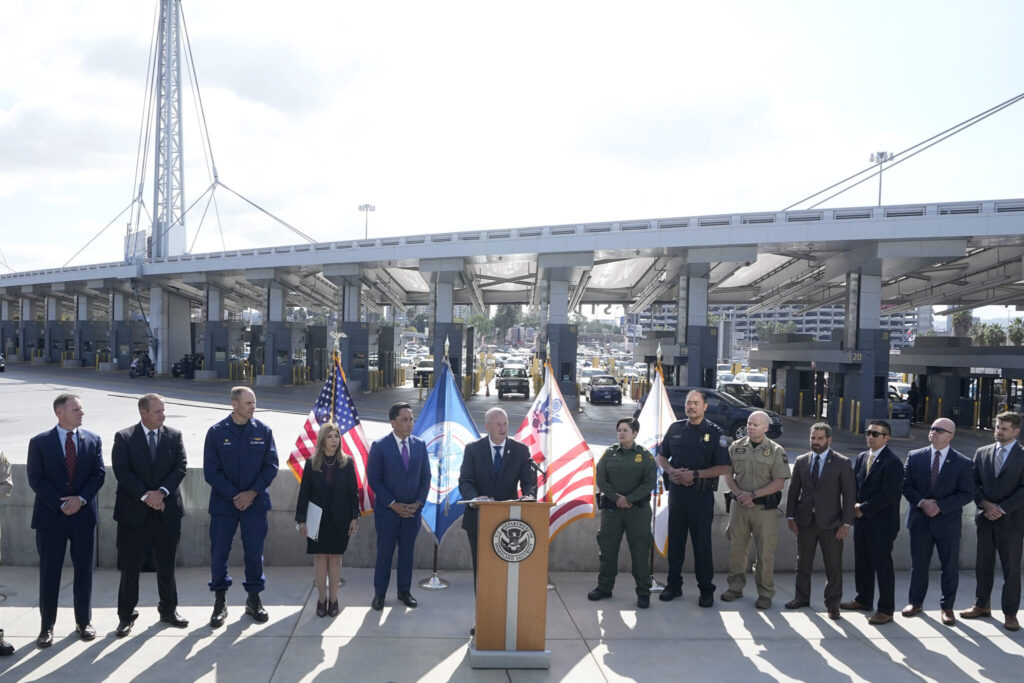In response to escalating overdose deaths, U.S. Customs and Border Protection (CBP) rolled out a comprehensive strategy on Thursday to crack down on materials traffickers use to produce fentanyl and other synthetic drugs. This strategy unites numerous agencies in the fight against the illegal drug trade.
Quick Read:
- Overdose deaths are at a record high.
- U.S. Customs and Border Protection (CBP) introduced a new strategy targeting materials used for making synthetic drugs like fentanyl.
- Collaborative efforts involve the postal service, express carriers, air carriers, and logistics firms.
- Focus on sharing data about suspicious goods, possible transit routes, etc.
- Target items include pill-making molds, presses, and chemicals.
- Increase noted in legal goods for fentanyl production arriving from Asia, especially at LA airports; these goods are transported to Mexico for drug production and then smuggled back to the U.S.
- Strategy aims to disrupt each part of the supply chain using data-driven intelligence.
- Initial focus on San Diego, with expansion to LA, San Francisco, and Portland.
- Partnerships encompass state, local, tribal, territorial levels, governments, commercial sectors, NGOs, and the global community.
- Troy Miller, acting CBP commissioner, announced the strategy at the U.S.-Mexico border.
- Significant portion (nearly half) of fentanyl seizures occur in San Diego.
- Drug trade has changed: fentanyl previously came mostly through mail, but now materials for its production are shipped or flown in.
- Notable seizures include 175 pounds of fentanyl-related chemicals in an LA airport cargo in June and dye/pill sets at JFK Airport in September.
- Miller emphasized the sophistication of traffickers but assured of robust countermeasures.
- Legal pill presses are DEA-licensed; CBP will verify licenses during inspections and target other drug-making precursors.
- This move is part of the Biden administration’s broader effort against the drug crisis.
- Recent actions against eight Chinese firms and their executives for facilitating fentanyl production.
- CBP aims to scrutinize more involved businesses, including shippers.
- DEA identifies Mexico and China as primary fentanyl sources for the U.S.; most precursor chemicals are from China.
- Companies often use deceptive practices like fake addresses to dodge law enforcement.
- Fentanyl, a potent opioid, is the leading cause of drug-related deaths in the U.S.
- CDC reports overdose deaths have surged over seven times from 2015-2021.
- Since 2020, over 100,000 annual deaths linked to overdoses, with two-thirds tied to fentanyl.
The Associated Press has the story:
US Govt plans to go after legal goods tied to illegal fentanyl trade
Newslooks- SAN DIEGO (AP)
In response to escalating overdose deaths, U.S. Customs and Border Protection (CBP) rolled out a comprehensive strategy on Thursday to crack down on materials traffickers use to produce fentanyl and other synthetic drugs. This strategy unites numerous agencies in the fight against the illegal drug trade.
CBP will team up with entities like the postal service, air carriers, and express delivery companies to exchange intelligence about questionable shipments, possible trafficking routes, and more to disrupt the flow of fentanyl and other illegal drugs. This will include monitoring legal items such as pill-making equipment and relevant chemicals.
It’s been observed that materials for producing fentanyl, a dangerous opioid, often fly into airports like Los Angeles from Asia. From there, they are transported to Mexico where drug cartels manufacture the drug before smuggling it back into the U.S. The initiative aims to dismantle every link in this supply chain using data-driven insights.
Initially, the focus will be on the San Diego region, with expansion plans to cities like Los Angeles, San Francisco, and Portland, Oregon. The strategy will bring together stakeholders from various sectors, including state, local, and tribal entities, law enforcement, governments, commercial industries, NGOs, and international allies to counter the deadliest overdose epidemic the U.S. has ever faced.

Making the announcement at the bustling U.S.-Mexico border crossing, Troy Miller, the acting commissioner of CBP, highlighted that San Diego is a hotspot, accounting for nearly half of all fentanyl seizures by the agency.
The trafficking landscape has shifted since 2016. Where once fentanyl primarily came through mail, now machinery and materials for its production arrive by ship and plane. For instance, in June, CBP officers at Los Angeles International Airport discovered 175 pounds of fentanyl-related chemicals in a box labeled as keyboards, intended for a U.S.-Mexico border warehouse. In another instance, officers at JFK Airport in New York confiscated 14 dye and pill sets from China.
Miller stressed the advanced tactics of these traffickers but assured that their countermeasures are equally formidable. All legal pill presses are DEA-licensed, and CBP officers will be on the lookout for unauthorized shipments, along with other precursors used in methamphetamine production.
This move is part of the Biden administration’s broader battle against the drug epidemic. Recently, sanctions and indictments were levied against Chinese entities suspected of supplying chemicals for fentanyl production.
The DEA notes that most of the fentanyl and its precursor chemicals in the U.S. originate from China and Mexico. Deceptive practices, like using counterfeit return addresses, are commonly employed to evade detection.
Fentanyl’s potency makes it the most lethal drug in America. The CDC reports that overdose deaths have skyrocketed over seven times between 2015 to 2021. Annually, since 2020, over 100,000 deaths have been attributed to drug overdoses, with around two-thirds linked to fentanyl.






